Chapter 26
New Media: Reading Newspapers, Magazines, and More
In Chapter 12, we spoke about how the iPad has revolutionized the world of reading. The iPad is not only unparalleled in the realm of reading E-Books, but it is also unparalleled in dealing with new media such as online newspapers and magazines, PDF files, and more.
In this chapter, we will explore how to enjoy new media with your iPad and its vivid screen and terrific touch interface. The iPad is even set to revitalize the comic book industry with comic books that look beautiful and are amazingly interactive.
Newspapers on the iPad
Remember the days when newspapers were delivered to the house? Invariably, if there was one puddle in the sidewalk, that was where the newspaper landed! You took it out of that plastic bag, shook it off, and tried to make out what was in section two—the section that got soaked.
Enter the iPad Interactive Newspaper
Well, those days may be gone forever. Users now have the opportunity to interact with their news and even get their paper delivered every day—but to their iPad instead of their driveway.
New this year is an iPad-only newspaper from News Corps.: The Daily. The Daily is a highly interactive news app that is delivered new each morning (currently US only) right to your iPad.
Many newspapers are developing apps for the iPad, with new apps seeming to appear every day. We will also take a quick look at several apps for the iPadfrom the largest newspapers in the United States and examine how they revolutionize reading the news (see Figure 26–1).
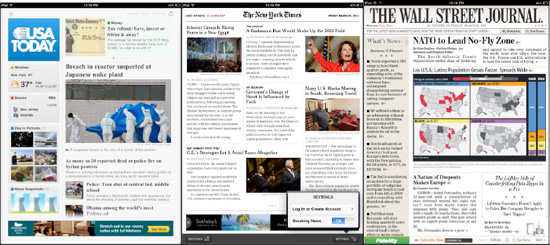
Figure 26–1. The front pages of various newspaper apps
The Daily
The Daily deserves special mention because it is the first (of most likely many) iPad-specific daily newspapers. The app is free to download in the App Store, and it comes with a free trial of two weeks to a month or so.

After the free trial, The Daily reverts to a subscription model—not unlike a traditional newspaper. However, the rates are more favorable than a traditional newspaper at this time—just $.99 a week or $39.99 for an entire year.
When you touch the icon for The Daily app, you will first see that the days' news is being retrieved and delivered to the iPad.

Once the news is delivered, navigating The Daily is quite intuitive. The experience starts with a typical Front Page section that displays the main story of the day.
At the top, however, you can quickly jump sections to News, Gossip, Opinion, Arts and Life, Apps and Games, or Sports. Just touch the desired section at the top of the Front Page to jump there.

At the top is a Visual Browser. Touch the very top of any article and you can see small thumbnails of all the pages of The Daily. Just scroll through and find the page that interests you.

Tapping the button in the upper-right corner opens up The Carousel view, which allows you to browse The Daily in large page-by-page images.

The lower-right corner has a button for the Control Panel. This allows you to watch a daily video, listen to stories read aloud, or autoplay through The Carousel to find a story that interest you.
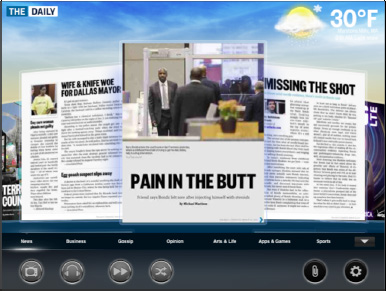
Tap the Share icon ![]() and you can easily share a web-friendly version of the story with e-mail contacts, Facebook Friends, or on Twitter.
and you can easily share a web-friendly version of the story with e-mail contacts, Facebook Friends, or on Twitter.

Popular Choices: The New York Times, The Wall Street Journal, and USA Today
Each of these three papers has a circulation of millions of readers, and each has taken a different approach to bringing you the news on the iPad.
NOTE: You can always go and visit the dedicated web site for any news source. Some are optimized for the iPad, while others offer you a full web experience. Others will require registration and/or a paid subscription to view the paper's full content.
You must first follow several steps in the App Store to find, download, and install a news app on the iPad:
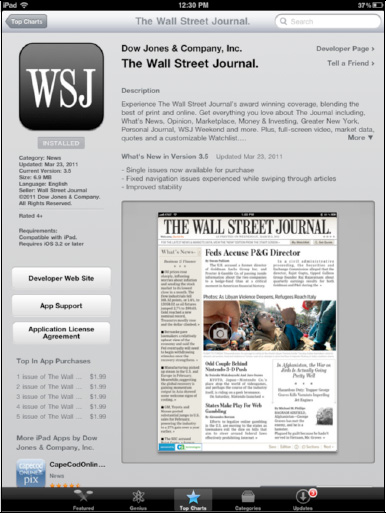
- The first step is to locate your desired news app in the App Store. You may find one or more news apps in the Featured section.
- Next, touch the Categories button at the bottom of the page and then touch the News icon. This takes you to all the news apps in the App Store. Browse or search for your desired news app, just as you would for any other app.
- Once you locate the desired news app, download it as you would any other app.
NOTE: Many news apps are free. Others are free to try, but require you to buy them to continue receiving them. Still others offer limited free content, but you need to subscribe to gain access to the full content.
- Once the app is downloaded, touch its icon to start it.
The New York Times App
The New York Times offers a slimmed-down version of the paper in its free iPad app.
At the bottom-left corner is a button labeled Sections. Touch the Sections button and all the available sections are displayed.
The caveat is that most sections have a blue dot next to them, which signifies that registration (subscription) is required to view them.
The Top News and Most E-Mailed sections are always available.

NOTE: The New York Times have very recently moved to a subscription model. Touch any section with a blue dot and you will be taken to the latest pricing.
Navigating The New York Times app is as simple as sliding screens from right to left. You can touch a section, and then slide the screen to the left to see additional pages in that section. Touch an article again, and then slide the screen to the left again to continue reading additional pages in that article.
To go back to the Home page, touch the Top News button in the lower-left corner.
To e-mail an article, just touch the E-mail Article button ![]() in the upper-right corner. This button is only available when you are inside an article, not on the Home page.
in the upper-right corner. This button is only available when you are inside an article, not on the Home page.
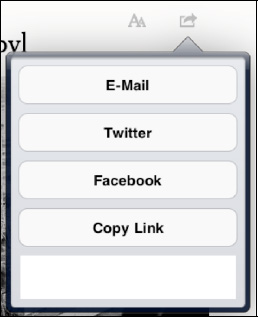
Moving Through and Enjoying Content
After you play for a while with all these various News apps—you will begin to realize that there is no real standard for navigating around them. This means you'll need to become familiar with each app and its own way of navigating articles, as well as how to return to the Main screen. Here's a short guide for generally navigating these types of apps:
Showing or Hiding Control Buttons or Captions: Tapping the screen once will usually show hidden controls or picture captions. You can tap them again to re-hide them.
Getting to the Details of an Article: Usually you tap the article or its headline to see the next screen.
Getting to the Next Page of an Article: Usually you swipe right to read more. Sometimes you swipe up.
Viewing a Video: Tap a video to start playing it. Usually, this plays the video in the same portion of the screen without expanding it.
Expanding a Video or Image Size: You can try pinching open inthe video or image, and then double-tapping the video or image. Look for an Expand button; you may also try rotating to Landscape mode.
Reducing a Video or Image Size: You can try pinching closed inside the video or image. Look for a Close or Minimize button; you may also try rotating back to Portrait mode.
The Wall Street Journal App
TheWall Street Journal app, however, takes a different approach to delivering the news. Once the app is launched, you will be prompted to create an online account.
Once the account is created, you have access to a subset of content from The Wall Street Journal.
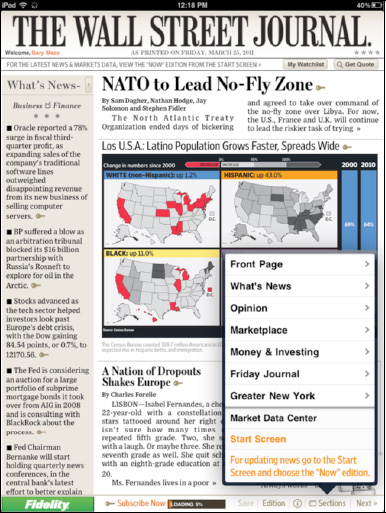
Material that is unavailable to free account users is marked with a small Key  icon, indicating that material is locked.
icon, indicating that material is locked.
If you fully subscribe to The Wall Street Journal app, all articles and tools become available.
Touch the Sections button at the bottom to see all the sections of current issue of the paper.
The Home page of the app shows this week's newspapers along the top; it shows Saved Articles, Saved Selections, and My Watchlists below this week's newspapers.
In the free version of the app, only the Now section of the news along the top row is viewable. All other papers from the week have the Key icon next to them; as mentioned earlier, this indicates they are locked and viewable only by paying subscribers.

The articles that do not have a small Key icon next to them are available for you to read. Touch an article and it loads onto the iPad.
Similar to TheNew York Times app, The Wall Street Journal app lets you slide the screen to the left to continue reading the article.
You will notice that some articles have a video clip embedded where you would normally find a photograph. Touch the video and it will start playing right inside the paper—a very cool and interactive feature.
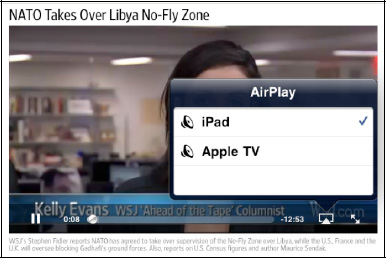
NOTE: Some apps—like the Wall Street Journal app—are AirPlay compatible, so you can send your video right to your TV (see Chapter 10: “Viewing Videos, TV Shows, and More”).
Adjusting Options: Font Sizes and Share, E-mail, or Save an Article
In the various apps for reading newspapers and other content, you will usually find a button or icon to change font sizes. That same button or a button near it may also allow you to share, save, or e-mail an article to a friend. Some apps allow you to share the article with a social networking site, such as Facebook or Twitter.
TIP: Almost all newspaper or magazine apps will allow you to change font sizes and e-mail or otherwise share an article. Look for a button or icon that says Tools, Options, Settings, or something similar. In some apps, the font-size adjustment option will show Small A and Large A icons.
In the Wall Street Journal app, touch the Share button in the lower-right corner to share an article. This app gives you options to save or e-mail an article:
Email Article: This option sends this article in an e-mail.
Facebook: Share the article on your Facebook page.
Twitter: Post a link to the article on your Twitter account.
The Wall Street Journal app also gives you three choices for text sizes:
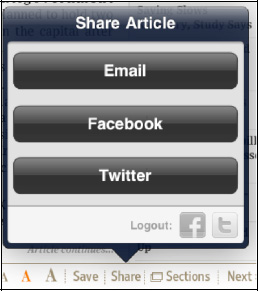
- Small Text Size
- Standard Text Size
- Large Text Size
In the USA Today app, the Font Sizes and Share icons are separated, as shown to the right.
Touch the Share icon to e-mail an article or share it with a social networking site.
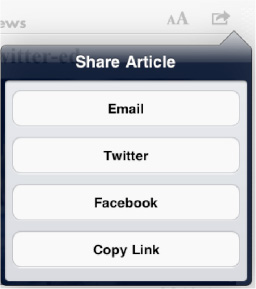
Similarly, you can touch the Small A/Large A icons to adjust font sizes.
Doing so brings up a Slider control that lets you slide from smaller to larger font sizes.
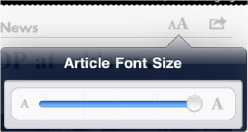
Tap the screen anywhere off the Slider control to hide the control.
In the New York Times app, you have one button in the lower-right corner of the article screen that allows you to adjust Settings.
In this app and others, you will often see an option for Breaking News alerts. These will send you an Alert notice as soon as something important happens and gets posted to the site.
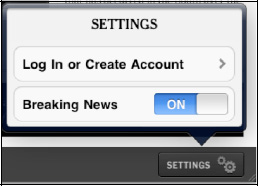
USA Today App
The USA Today app has a very similar look and feel to the print version of its daily newspaper. Touch the USA Today icon and you will be taken to the Home section of the paper. One of the first things you will notice is a group of rotating stories along the top of the screen.

The main stories are listed along the right-hand side. You can scroll through these stories; when you find a story you wish to view, just touch the headline.
When you are in the Article View mode, you can adjust the font size by touching the Font Size icon in the upper-right corner. You can also e-mail the article by touching the Share icon and touching E-mail from the dropdown-box list.
If an article is more than one page long, you can scroll upwards to continue reading the article. Sliding the screen from right to left will advance you to the next article.
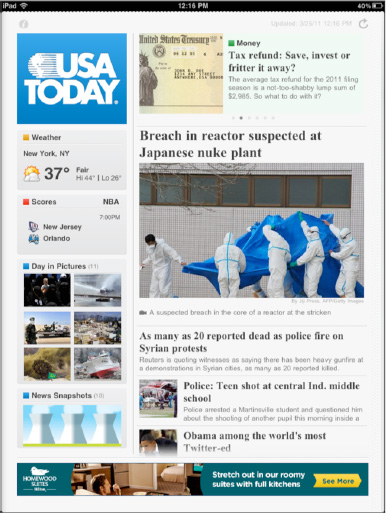
TIP: If you touch the Weather box, you can customize it for your local weather by entering a city name or zip code.
To go to back to the Home screen, touch the Newspaper icon in the upper-left corner.

To go to another section of the paper, touch the USA Today icon at the top-left corner of the Home page, and then choose either Money, Sports, Life, Tech, or Travel to advance to that section of the paper. To go back, touch the same icon in the upper-left corner.
There are currently no locked articles or subscriptions required to use the USA Today app, but this may change at some point in the future.

Magazines on the iPad
It is no secret that both newspapers and magazines have suffered declines in readership over the last few years. The iPad offers a totally new way of reading magazines that might just give the industry the boost it needs.
NOTE: Soon, all current magazine apps will be required to switch to the new (iOS 4.3) subscription model. As a consequence, in-app purchase of individual issues may remain, but subscription offers will likely be added (and some publishers may pull their apps and leave the store instead).
Pictures are incredibly clear and brilliant on magazines for the iPad. Navigation is usually easy, and stories seem to come to life—much more so than in their print counterparts. Imagine adding video and sound integration right into the magazine, and you can see how the iPad truly enhances the magazine-reading experience.
Some magazines, such as Time Magazine, also include links to live or frequently updated content. These might be called Newsfeeds, Live Edition, or Updates. Check for them in the magazine you purchase—these will give you the most up-to-date information.
TIP: Make sure to check the user ratings for a magazine or other app before you purchase it. Doing so may save you some grief and/or some money!
The App Store is filled with both individual magazines that can be purchased (or limited content that can be viewed for free) and magazine readers that provide a sampling of many magazines, allowing you to subscribe to weekly or monthly delivery of a given magazinefrom your iPad.
More and more magazines are offering digital editions in the App Store. Time, Newsweek, Wired, Outside, GQ have such editions, and many more seem to be popping up each day.
One magazine with strong reviews is Time Magazine for the iPad, which is free to download. It includes sample contentas well as in-app purchases that can be made on a per-issue basis. Most issues retailed for US $4.99 at the time of writing.
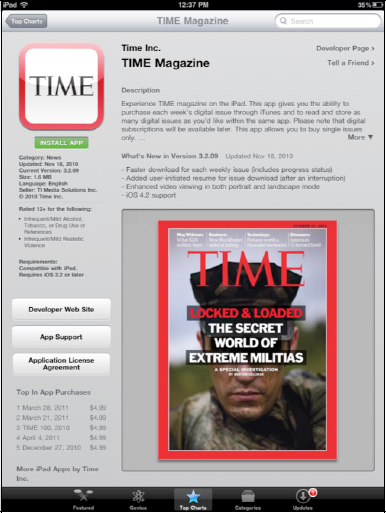
Unlike when using other media, you don't touch an article to read the magazine; instead, you simply slide from screen to screen paging through the magazine.
To make the text more viewable, Pinch and Zoom both work in many of the magazine apps.
Many magazines are for sale in the App Store, including Popular Science, Men's Health, WIRED, Outside, GQ, Time, and others. Most are priced from $2.99 to $4.99 per issue.
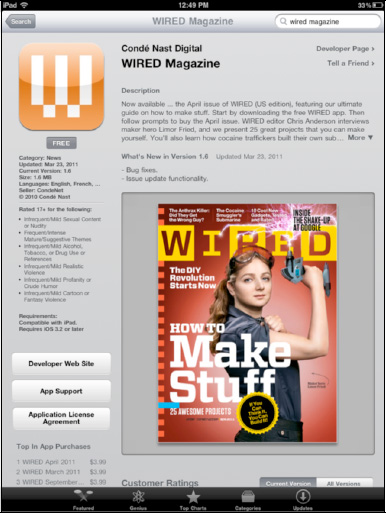
Navigating Around Magazines
As Figure 26–2 shows, there are various types of home pages, depending on the magazine. This example shows the Time Magazine app and the Newsweek app side-by-side.
The Newsweek app gives you some free content to browse, whereas the Time Magazine app lets you preview issues and then buy content.
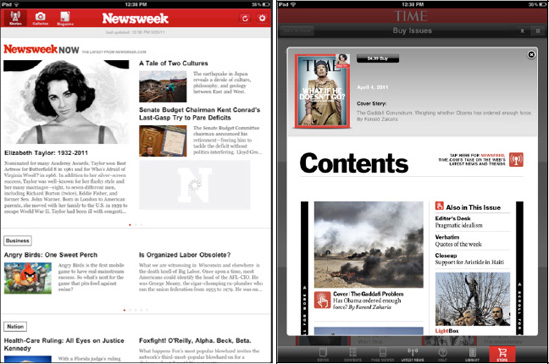
Figure 26–2. Pages from the Time Magazine and Newsweek apps
The Zinio Magazine App—a Sampler
One app, Zinio, takes a unique approach. The Zinio app is free in the App Store, giving you a sampling of more than 20 magazines. Each sample has a few full articles to read. Reading an article in Zinio requires following a few simple steps:
- Begin by touching the cover of the magazine you wish to read.
- Next, touch the screen and you will see a sliding bar across the bottom that shows screen shots of the articles available for free.
- To advance pages, slide the screen from right to left or touch the image along the bottom bar to jump to that page.
- Some magazines will be giving away full, free issues. Just touch the Featured button at the bottom to see what is available for the week. Touch the magazine cover to download the issue.
- Touch the Library button to see those issues stored in your library for viewing.
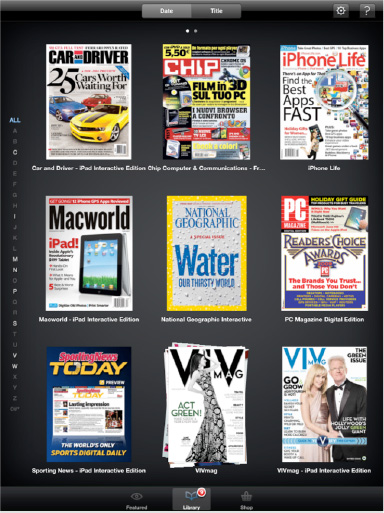
This image is from a free issue of Car and Driver; it was available for download in the week we composed this chapter.
To subscribe to any of the magazines featured in Zinio, touch the Shop button at the bottom right of the screen.
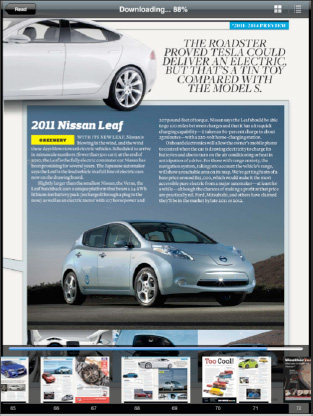
You can navigate magazines by category along the left-hand side, or you can slide the icons at the bottom to see available magazines.
There are many popular magazines from which you can choose. The categories cover everything from art to sports and much more. Prices vary, but you will often find a price for a single issue and a price for a yearly subscription.
For example, at the time of writing the newest issue of Popular Mechanics was $1.99 on Zinio, with a yearly subscription of $7.99.
Some of the subscriptions make great sense. A single issue of Bike Magazine (one of my favorites) was $5.99 at the time of writing, but a yearly subscription was only $9.00.
A closer look showed me that there were more than 16 cycling magazines that one could subscribe to.
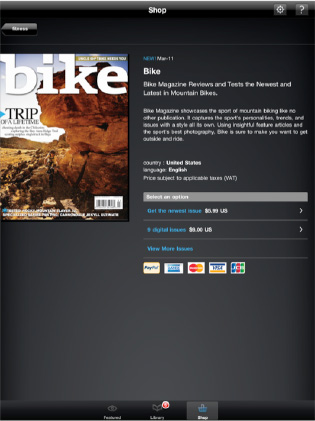
Comic Books on the iPad
One genre of new media poised for a comeback with the advent of the iPad is the comic book. The iPad, with its relatively large high-definition screen and powerful processor, makes the pages of comic books come alive.
There were already a few different comic book apps available when we wrote this book, but none from a company more famous than Marvel Comics.
Locate the Marvel Comics app in the App Store. Go to Categories and then go to Books. The app is free, and comic books can be purchased from inside the app.
At the bottom of the Home screen are three buttons: My Comics, Store, and Settings. Purchases you make will be under the My Comics heading.
The App Store gives you the opportunity to download both free comics and individual issues for sale. Most sell for $1.99 per issue.
You can see four tabs along the top:
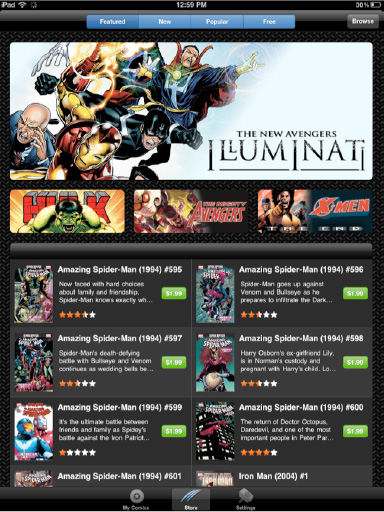
- Featured
- New
- Popular
- Free
Each tab takes you to a new list of comics to browse, much like the iTunes store.
Touch the Browse button to browse by Genre, Creator, Storylines/Arcs, or Series. Or you can type in a search to find a particular comic.
You can read a comic book in one of two ways. First, you can swipe through the pages and read one after the other. Second, you can double-tap a frame to Zoom in and then tap the screen to advance to the next frame in the comic strip. From there, you can just swipe from right to left to advance a frame; or, if you want to go back, swipe from left to right.
To return to the Home screen or see the on-screen options, just touch and hold anywhere on the screen for about a second and then release. You will see a Settings button in the top-right corner, a page Thumbnail view (just like Photos) at the bottom, and a Close button in the upper-left corner that will take you to the Home screen.

NOTE: The makers of this app, ComiXology, also make the Comics app that contains the Marvel comics, as well as a bunch of others, including Archie, Image, and Top Cow. You will also see DC Comics and other vendors in the App Store.
The iPad As a PDF Reader
In Chapter 12, we showed you how to open attachments in your e-mail, including PDF files. While you can read just about any type of attached file, you don't have the option of saving PDF files on the iPad for future viewing.
Fortunately, there are a few programs available that turn the iPad into a very capable PDF viewing program. One such program with multiple uses is GoodReader.
The GoodReader app is in the App Store in the Productivity section. At the time of publishing, this app was only US $4.99.
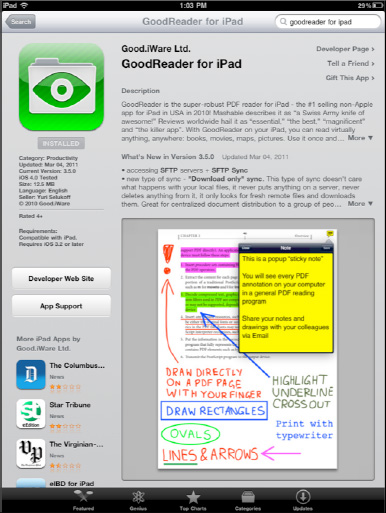
Transferring Files to Your iPad
One of the great things about the GoodReader app is that you can use it to wirelessly transfer large files from your Mac or PC to the iPad for viewing in the GoodReader app. You can also use GoodReader for document sharing in iTunes, as we discussed in Chapter 3: “Sync Your iPad with iTunes.” Follow these steps to transfer a file with GoodReader:
- Touch the small Wi-Fi icon at the bottom to bring up the Wi-Fi Transfer Utility. You are then prompted to type in either an IP address into your browser or a Bonjour address if you use the Bonjour service.

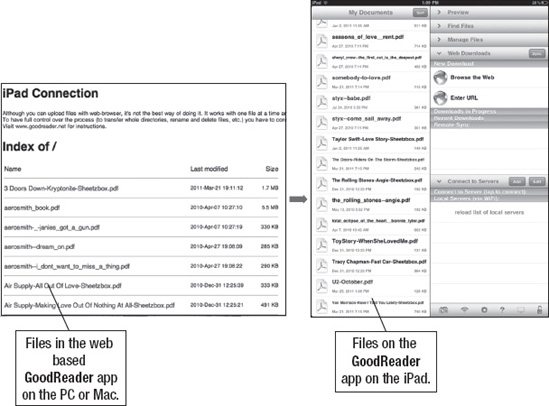
- Type the address shown in the pop-up window from the GoodReader into a web browser on your computer. Now, you can make your computer act as a server. You will see that your computer and iPad are now connected (see Figure 26–3).
- Click the Choose File button inside your web browser on your computer to locate files to upload to your iPad.
- Once you have selected the file, click Upload Selected File and the file will be automatically transferred to your iPad inside GoodReader (see Figure 26–4).
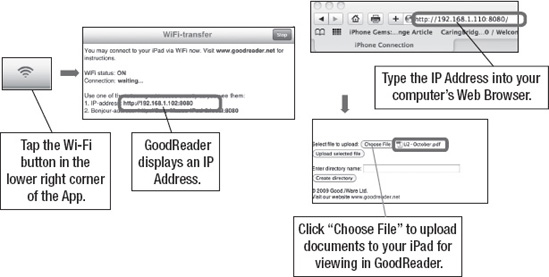
Figure 26–4. Uploading a file to your iPad
Why is this useful? Well, for one of the authors (Gary), the iPad has become a repository for more than 300 pieces of piano sheet music. This means no more downloading PDF files, printing them out, putting them into binders, and then trying to remember which song is in which binder. Now, all his music is catalogued on the iPad. All he has to do is put the iPad on the piano, and he has access to all his music in one place.
NOTE: You can also transfer Word, Excel, and PowerPoint files in the same manner. We believe that using the document transfer utility in iTunes might make this a bit easier (see Chapter 19: “Productivity and File Transfer” for more information).
Navigating the GoodReader app's PDF viewer is quite easy. Tap the center of the screen quickly to bring up the onscreen controls. You can then go to your library or touch the Turn Page icon to turn the page.
The easiest way to move through pages is simply to swipe from right to left on the screen.
You can also flick up or down to turn pages.
To go to another PDF file or another piece of sheet music, just touch the center of the iPad quickly and touch the My Documents button in the upper-left corner.
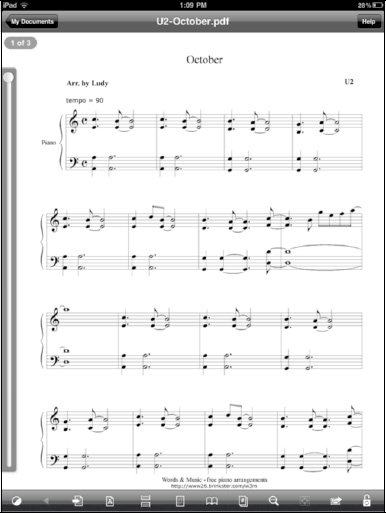
Connecting to Google Docs and Other Servers with GoodReader
You can also connect to Google Docs and other servers with GoodReader. Follow these steps to do so:
- In the Connect to Servers tab on the right-hand side of the GoodReader screen, click the Add button (see Figure 26–5).
- Select Google Docs. You can select from a number of different servers, including mail servers, MobileMe iDisk, Public iDisk, Dropbox, box.net, FilesAnywhere.com, MyDisk.se, WebDAV Server, and FTP Servers.
- Enter your Google Docs username and password to log in.
- Once you have made the connection, a new GoogleDocs Server icon will appear under the Connect to Server tab on the right-hand side of the page.
- Tap the new Google tab to connect to the server. (An Internet connection is required to connect.)
- Now you will see a list of all the documents you have stored on Google Docs. Tap any document and select the file type to download it. Usually PDF works well for this.
- Once the file is downloaded, it will appear on the left-hand side of GoodReader. Simply touch the file to open it.
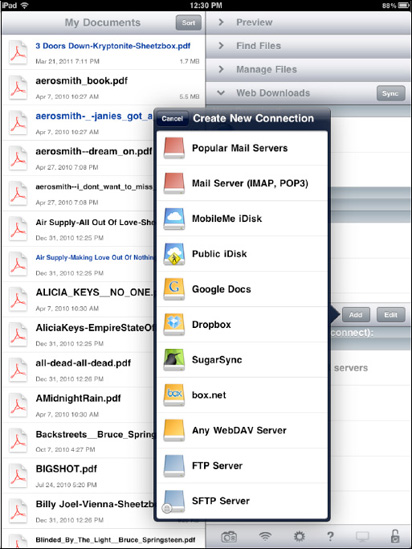
Figure 26–5. Connecting GoodReader to other document servers
